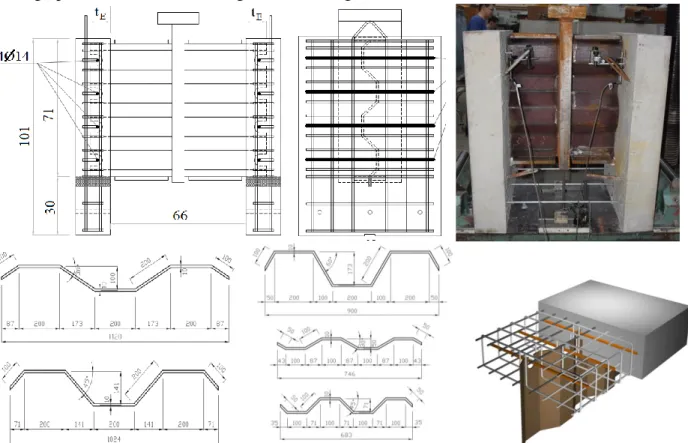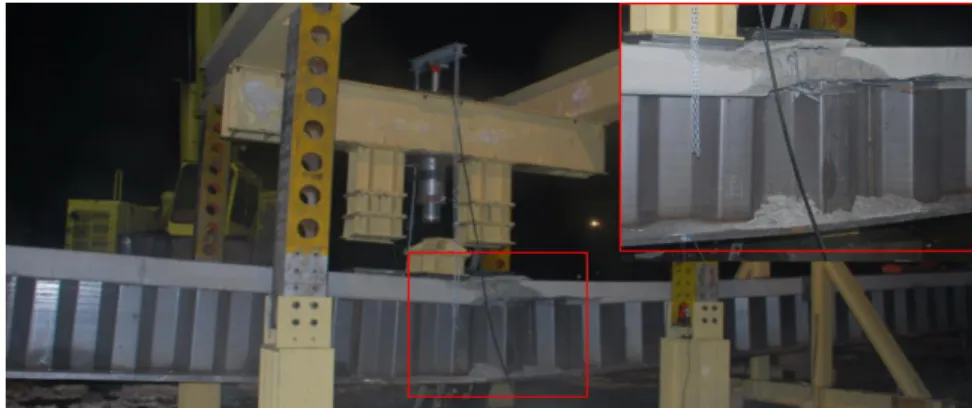Bridge Engineering Institute Conference 2019 (BEI-2019) Honolulu, Hawaii, USA, July 22-25, 2019
Investigation of innovative steel-concrete composite and hybrid bridge girders using corrugated steel web
Balázs Kövesdi1*, Bence Jáger2, Péter Hegyi3, Mansour Kachichian4 and László Dunai5
1: BME Dept. of Structural Engineering, Budapest, Hungary; kovesdi.balazs@epito.bme.hu
2: BME Dept. of Structural Engineering, Budapest, Hungary; jager.bence@epito.bme.hu
3: BME Dept. of Structural Engineering, Budapest, Hungary; hegyi.peter@epito.bme.hu
4: BME Dept. of Structural Engineering, Budapest, Hungary; kachichian.mansour@epito.bme.hu
5: BME Dept. of Structural Engineering, Budapest, Hungary; dunai.laszlo@epito.bme.hu
*: corresponding author
Keywords: corrugated web, composite girder, hybrid girder, innovative shear connector
Abstract: Experimental and numerical research program is carried out on steel-concrete composite and hybrid girders having trapezoidally corrugated webs at the Department of Structural Engineering at the Budapest University of Technology and Economics in Hungary. The analysed girders are formed by reinforced concrete top flanges and steel (composite) or pre-stressed concrete (hybrid) bottom flanges with steel corrugated web. The shear connectors between the steel-to-concrete junctions are embedded type connections using transverse reinforcement through the web openings or vertical headed studs. The research program includes study of (i) the embedded shear connections by push-out tests; (ii) the bending-shear interaction behavior with special focus on the contribution of the concrete flanges to the shear resistance, (iii) large scale tests to prove the load carrying capacity of the designed bridge girder. The current paper gives general overview on the executed experimental research program having 56 push-out tests, 5 large scale (8 m long) beam and 4 full scale (24 m long) bridge girder tests.
1. Introduction
Composite and hybrid girders with corrugated web are increasingly used in bridge engineering due to its numerous favorable properties. Due to the features of corrugation, the application of corrugated steel webs leads to advantages for hybrid bridge structures. The web has a small stiffness in longitudinal direction, therefore the prestressing force remains in the concrete chords.
The resistance against buckling – locally and globally – increases, so the number of stiffeners or diaphragms may be reduced significantly. In comparison to flat web girders there is a high bending stiffness in transverse direction, which can be favorable during manufacturing. Due to the increased stiffness the web thickness may be reduced, therefore the dead load of the structure may be smaller leading to easier and faster building processes especially in case of incremental launching. Another advantage is that the concreting difficulty of thin reinforced concrete webs disappears, which also results in a faster and easier building process. The current research project has the aim to take benefits from these advantages and to improve the efficiency of the conventional pre-cast bridge girders using corrugated web as an alternative solution for bridges in the span range of 20-40 m. The paper gives a brief overview on the executed research work and gives a summary on the investigations which led to improve the design of corrugated web bridge girders.
Bridge Engineering Institute Conference 2019 (BEI-2019) Honolulu, Hawaii, USA, July 22-25, 2019
2. Innovative shear connectors
Shear connectors are one of the most important part of composite and hybrid girders, therefore special attention is given to their design. Standard based and reliable design methods are mainly available for headed stud connectors. If different connection layouts are applied, the design should be based on experimental background. Based on the literature review lack of experiences and research results have been found in the field of resistance and stiffness of embedded shear connections of corrugated hybrid girders. To contribute to this research an extensive experimental research program has been designed and executed including a total number of 56specimens with a wide range of structural details to investigate the structural behavior of this connection type.
Figure 1 gives an overview on the applied test layout, geometry of the specimens and on the investigated 5 different corrugation profiles. Two different shear connector configurations are investigated in the test program, (i) horizontal headed studs and (ii) perfobond type connections having open cut-outs on the corrugated web using rebars as connectors.
Fig. 1. Test specimen geometries, test layout and corrugation profiles.
During the research program 5 different corrugation profiles are investigated with two different embedding depths (100 – 150 mm). Further varied parameters are the diameter, the layout of the applied headed studs and reinforcing bars, the size and number of cut-outs on the corrugated web.
For each specimen configurations tests without any mechanical shear connector are also carried out to determine the shear resistance coming from the corrugation profile, as reference. Based on the test results the shear resistance coming from the corrugation profile is determined as a reference value. The different mechanical shear connectors (headed studs and transverse rebars) give additional shear resistance, which are determined and added to the reference resistance. The final research aim is to develop the resistance calculation method for the design of these innovative shear connectors. Further details on the research results are given in [1].
Bridge Engineering Institute Conference 2019 (BEI-2019) Honolulu, Hawaii, USA, July 22-25, 2019
3. M-V interaction behavior of composite corrugated web girders
3.1. Effect of corrugation on the interaction behavior
Previous studies showed that the M-V interaction behavior of corrugated web girders is more favorable than for conventional flat web girders. Results of previous experiments and numerical studies proved that the combined loading (M-V) does not reduce the bending and the shear buckling resistance of corrugated web girders having steel flanges [2,3]. The M-V interaction behaviour can be neglected in the design of corrugated web girders. However, it is also known, that for girders with heavy flanges, the flange contribution can have a significant effect on the shear buckling resistance, thus on the M-V interaction behavior. It can be the case of composite girders. Therefore, the current research program investigates the M-V interaction behavior of corrugated web girders with concrete upper flange. A total of 8 large scale test specimens are investigated having different M-V interaction pairs. One corrugation profile is tested in the experimental program, which is extended by numerical studies for different corrugation configurations. The obtained failure mode and resistances are presented in Fig. 2. Five significantly different M-V pairs are applied in the tests to cover a wide range of the M-V interaction curve and three duplications are executed to check the accuracy of the test results. The red lines on the graph shows the pure bending moment resistance of the composite cross-section and shear buckling resistance of the web alone. The measurements draw the attention on the significant importance of the M-V interaction behavior in case of composite corrugated web girders. Results show that it comes from the fact, that the flange contribution in the shear buckling resistance has a significant role in the structural behavior, which should not be neglected in the design. Further ongoing investigations are studying the flange contribution in the shear buckling resistance of steel and composite girders to improve the M-V interaction curve.
Fig. 2. Obtained failure mode and M-V interaction diagram based on test results
3.2. Full scale tests on innovative bridge girders
The designed bridge girders are tested by a full scale experiments on specimens with 24 m span length. Four test specimens are studied and loaded under three-point-bending and four-point- bending arrangements until failure. Two composite girders with concrete upper flanges (Fig. 3), and two prestressed hybrid girders (Fig. 4) are tested having the same corrugation profile. The structural behavior and the load carrying capacity of the specimens are studied in the experimental program. The bending moment resistance of the tested girders with accompanying shear force are measured. The test results proved the accuracy of the design method applied to the design of test specimens. The obtained failure mode was a bending type failure for all tested specimens at the mid-span region with a slight effect of shear. Results proved the applicability of the developed
Bridge Engineering Institute Conference 2019 (BEI-2019) Honolulu, Hawaii, USA, July 22-25, 2019
design method and the appropriate detailing of these bridge girders, which have numerous application examples around the word, but it is a novel girder type in Hungary.
Fig. 3. Full scale test of the developed composite bridge girder with corrugated web.
Fig. 4. Full scale test of the developed hybrid bridge girder with corrugated web.
4. Summary
The BME Department of Structural Engineering executed an experimental and numerical research program on the improvement of composite and hybrid bridge girders using corrugated web. The executed research and their results significantly helps to understand the structural behavior of girders with corrugated web and it improves their design methodologies used in the praxis.
Acknowledgement
Funding has been received from Hungarian R&D project under grant agreement No. GINOP-2.1.1- 15-2015-00659. Support was also given by the ÚNKP-18-4 and ÚNKP-18-3 New National Excellence Program of the Ministry of Human Capacities and by the János Bolyai Research Scholarship of the Hungarian Academy of Sciences; financial supports are acknowledged.
5. References
[1] B. Jáger, G. Németh, N. Kovács, B. Kövesdi, M. Kachichian: “Push-out tests on embedded shear connections for hybrid girders with trapezoidal web”, Proc. of 12th International Conference on Advances in Steel-Concrete Composite Structures, ASCCS 2018, València, Spain, June 27-29, 2018.
[2] B. Kövesdi, B. Jáger, L. Dunai: “Bending and shear interaction behaviour of girders with trapezoidally corrugated webs”, Journal of Constructional Steel Research, 121, 383-397, 2016.
[3] B. Jáger, L. Dunai: “Flange buckling behavior of trapezoidally corrugated web girders subjected to bending and shear interaction”, Proc. of Annual Stability Conference, Baltimore, USA, p. 13, 2018.


